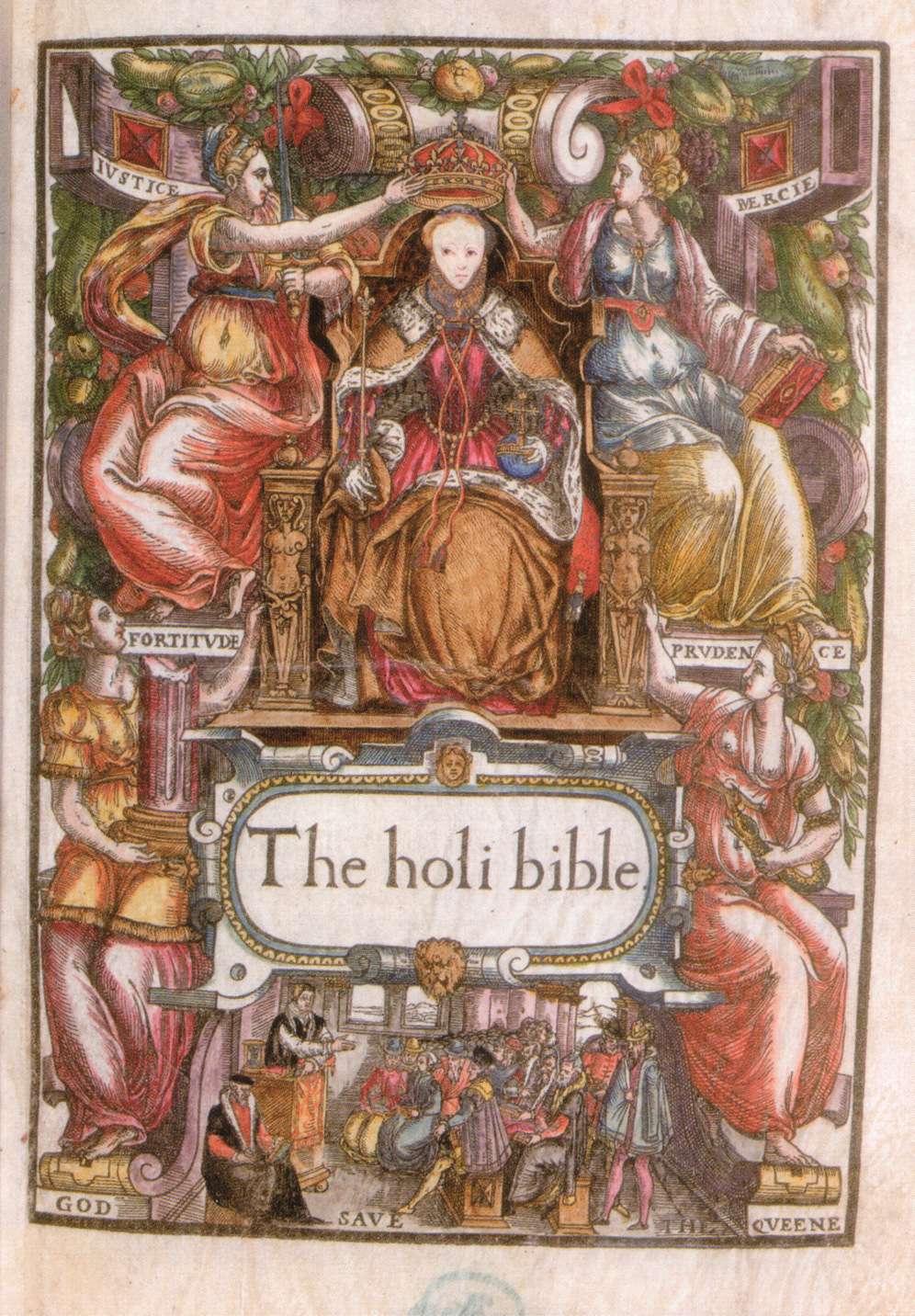Monday, November 23, 2009
titus...
So far this play presents an interesting plot-line. It is a little complicated and I definitely had to read through it a couple times before I really understood exactly what was happening. I am impressed with all the action that is happening so far. Already I have seen four dead bodies! I know it is going to get really good when there is so much gore to start off with. I feel like I can't really make up my mind about any of the characters yet. I think Titus is a good guy even though he killed his own son...but that was an extenuating circumstance. I guess. I think I am definitely skeptical about Saturninus and Bassianus. They just seem like really sketchy characters to me. Tamora is awesome. She is a fascinating female character - even for Shakespeare. I like her so far. We will see how my opinions progress as I move along throughout the play. Interesting first act though...for sure!
Thursday, November 19, 2009
Research Blog # 4 - The Bishops BIble

This is the edition of the Bible that Shakespeare would have been familiar with. It was an English translation of the Bible approved by the Church of England in 1568 and it was "extensively revised" in 1572. Later it was used as the base for the translation of the King James Version in 1611. It was developed because the people of the Anglican Church were displeased with the Geneva Bible and they felt that the Great Bible "was severely deficient." It was not meant to be a domestic bible, but one that was for readings at a church service. The first edition was really big and contained over 1oo full-page illustrations.
>http://en.wikipedia.org/wiki/Bishops%27_Bible
Wednesday, November 18, 2009
Research Blog #3 - "Jew Poisoning a Well"

This woodcut is from Pierre Boaistuau's Histoires Prodigieuses. It is dated around 1569 and depicts a Jewish man poisoning a well that the Devil is urinating into and in the background there is a child hanging on a cross. All these images support Anti-Semitic beliefs about Jews in the Early Modern period and each part represents a different stereotype of the Jew. There is the stereotype about Jews being in a relationship with the Devil, a common fear was that Jews were very dexterous with poisons, and there was another morbid belief that Jews sacrificed and ate children. While this is all very disturbing, it provides insight about the perception of Jews in Early Modern England.
"Chop off his head"..."Off with his head"
Richard gets more and more decapitation-happy as the play progresses. As soon as he started talking about killing the two boys for no real reason, I began to feel less sympathy for the morbidly intriguing social climber. I feel like his evilness is getting out of control and it is really bizarre to see how he continues to fool people even though he has killed so many people and said so many bald-faced lies. A prime example is in Act IV scene 4, when Richard is tries to (and succeeds in) convincing Queen Elizabeth that he should be able to marry her daughter, Elizabeth. Queen Elizabeth already knows what horrors Richard is capable of! How can she be so impressionable? Richard is clearly a first class smooth talker. His confidence is unbelievable and fascinating, much like the rest of his qualities. In short, as the play goes on, Richard really begins to fulfill his monstrous descriptions and expectations. His animal descriptions, quick temper, lack of conscience, and ability to manipulate people with his words is astonishing and I would easily attribute it all to his monstrosity. I am still intrigued by Richard and the psychology of his character, but I am less sympathetic to him now. I think he deserves no sympathy.
Thursday, November 12, 2009
Research Blog #2 - Jew of Malta

The Jew of Malta is a play written by Christopher Marlowe in the year (probably) 1589. It is considered a very strong influence for Shakespeare's Merchant of Venice. It presents the Jew main character, Barabas, as a corrupt, money loving, villain. Early Modern Europeans had very strong prejudices against the Jewish people (even though there weren't any in England during the time thanks to the Edict of 1290). They perceived the Jew as being usurers and obsessed moneylenders in the economic world, and Christ-killers in the religious world. This play supports all kinds of negative ideas about Jews that were present in the time. There seem to be no true redeeming qualities about Barabas - he poisons an entire convent for Pete's sake! And there is not a positive alternative for him in the end. People in England at this time, ate stuff like this up. They loved it. What a reflection of a culture!
"and seem a saint when most i play the devil"
There is absolutely no denying that Richard is a nasty, twisted, vile, devil of a character. But somehow, he seems attractive to readers...how is this so? We must be attracted by the honesty and the way he takes us into his confidence. To me it just seems wrong in retrospect. However, I do feel like this is a feeling that lasts throughout the play for me so far. Everything is so disturbing and crazy the whole time that I almost don't feel bad for anyone. Well except Clarence. He was just a nice guy. But Lady Anne was just too gullible or sadistic or weak or something. All the rest of the women in the play make up a very strange and interesting part of the play - I can't really figure them out yet. Queen Margaret might be my favorite character. She is really nuts! The parallels between Lady Anne and Queen Margaret come in their curses and witty exchanges with Richard. I find this play partially disturbing and disturbingly interesting. It is one of those things that is just so awful that you cannot look away. I can't wait to see how the story progresses.
Wednesday, November 11, 2009
Love Questions and Breaking the Rules
I ended up really enjoying Twelfth Night all the way through. I found the gender role questions really interesting and the whole play was really funny. The pairings in the end were so ridiculous and quick that they did not seem completely realistic, but I suppose the entirety of the play was pursued in that light. My feelings were not hurt at all by the dismissal of Malvolio, because he was such a kill-joy anyway (and how ironic that he ended up having some of the funniest scenes); I did however, feel a little bad about Antonio. In my experience with Shakespeare, the Antonios never really get the best deal. I mean they usually come out OK but they are not ever the real winners (note Merchant of Venice and The Tempest). Sir Andrew was just kind of a joke ("a boob" in Dr. Staub's fitting words) the whole time and it didn't really bother me that he was forgotten in the end either. I did find the duel/letter confusion with Viola/Cesario pretty funny and an interesting commentary on the innate-ness of masculinity and femininity. Shakespeare's ideas about homosexual love, and the easiness of the shift between male and female come through in a really interesting way at the end of the play. For example the Viola and Orsino plot makes an interesting turn and exit. Orsino still refers to his love as Cesario and Viola/Cesario is still in his man's clothing when they exit. This leaves the audience with a really interesting final image of love and homosexual (gasp!) love on the stage.
Tuesday, November 3, 2009
VIOLA-OLIVIA-M.O.A.I
So far I love the good humor found in this play! It is a welcomed relief from the underlying tensions of the other comedies we have read so far. Not that this one is lacking innuendo and social commentary, but it is done in a much less offensive way for everyone involved (except Malvolio haha). We have been discussing in class the crazy gender role portrayal that this play deals with in humor. Of course Viola is a natural point of discussion: the actor that played her is a man, who is playing Viola (a woman), who dresses up in the play as a man (Cesario). Good Lord that is confusing! Then of course there is the twisted love triangle between Viola/Cesario - Olivia- and Orsino. And then there is the "gentlemanly" love between Antonio and Sebastian! If you have a little bit of a headache to go with that madness, you are not alone. But what makes it all bearable is that it is FUNNY. It is very funny and the crazy gender madness only increases the humor. I think it is fascinating that Shakespeare makes a potentially touchy subject an object of humor and easy acceptance. Shakespeare makes the idea of gender something that seems less permanent and more suceptible to change. This concept is pretty revolutionary for his time and even for ours...
Monday, November 2, 2009
Research Blog: Primary Source 1

This is an image of Michaelangelo's David. It was carved from marble in 1515, it is located in San Pietro (Saint Peter) in Rome. I am interested in this because it provides a physical representation of a strong Jewish stereotype of the Early Modern Period: horns. It was a common belief that Jews were associated with the devil, but that is not where this stereotype came from. It came from the Bible: Exodus 34:29-35 tells the story of when Moses descended from Mt. Sinai. It says "the skin of his face shone" the Hebrew for "sun on his face" is qaran which can also translate to mean horns. I think it is interesting that such a well known artist would choose to incorporate the horns in his sculpture of Moses. This shows the heavy influence of Jewish stereotypes that are present during the period.
>http://en.wikipedia.org/wiki/Moses_(Michelangelo)
Subscribe to:
Comments (Atom)
